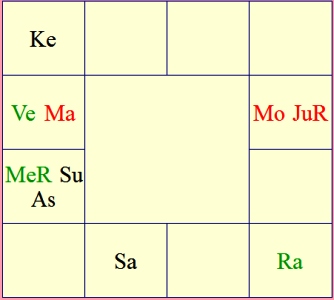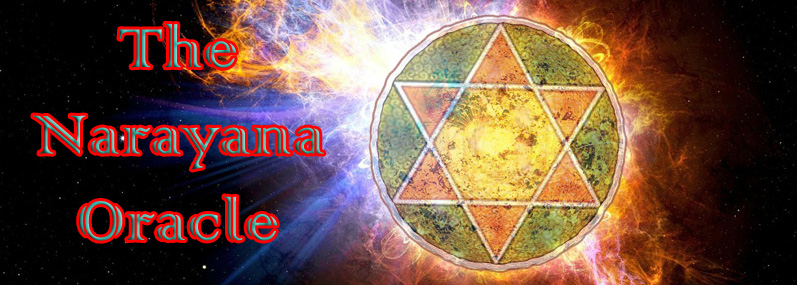 The full moon occurs in Ashlesha nakshatra – the nakshatra lord is Mercury – currently retrograde. Retrograde means “to do good“, and while the madding crowds say communication becomes difficult during during Mercury retrograde, how the planets deal with us can be modified … it is up to us how we use the planets; they can raise us up or pull us down, as the pundits tell. Modification of Mercury retrograde for you personally could come about easily as Mercury is retrograde in Capricorn until 12 February. Capricorn is a movable sign, so effects can be modified somewhat easily in a movable sign – by approaching Mercury with the following shakti mantra: Om Aim Bhum Budhaya Namaha. “Aim” is vachana shakti, the power of articulation, calling, guiding and teaching.
The full moon occurs in Ashlesha nakshatra – the nakshatra lord is Mercury – currently retrograde. Retrograde means “to do good“, and while the madding crowds say communication becomes difficult during during Mercury retrograde, how the planets deal with us can be modified … it is up to us how we use the planets; they can raise us up or pull us down, as the pundits tell. Modification of Mercury retrograde for you personally could come about easily as Mercury is retrograde in Capricorn until 12 February. Capricorn is a movable sign, so effects can be modified somewhat easily in a movable sign – by approaching Mercury with the following shakti mantra: Om Aim Bhum Budhaya Namaha. “Aim” is vachana shakti, the power of articulation, calling, guiding and teaching.
This fortnight begins with a nice Gaja Kesari yoga of the Moon with Jupiter in Gemini. Gaja means elephant and Kesari means lion, and a form of this yoga occurs 12 days each month when the Moon is conjunct Jupiter, and when the Moon is in the 4th, 7th and 10th houses from Jupiter. (in an angle from Jupiter). It also occurs 4 times a day when the rising sign is in an angle from Jupiter. Currently, Jupiter is retrograde. The idea is that the angles from Jupiter create a situation of strength.
Another important aspect is that the Full Moon sends energy. In Australia, the night-drivers know that Kangaroos are on the move all over Australia on the night of the full moon, and drive carefully in places where Kangaroos feed. The Hierarchy have advised us that the times of the Full Moon are times when energy is magnified, and multiplied. Groups sitting together in meditation on peace, harmony, goodwill towards all have a manifold affect on the energies surrounding our planet when they do this on the Full Moon day. If it is not possible to do so on the actual day, then, we have been told, the day before or the day after will also serve as days of excellence in sending out positive harmony, peace and helpful energies to all places on our Earth.
The Moon will be conjunct Rahu on 8 and 9 February, and then between Rahu and Saturn, both malefic planets. When the Moon is between malefics, this is called papa ketari yoga, a scissors binding, and the feeling of restriction will result. Ditto when the Moon is conjunct Saturn in Scorpio, clarity and strength in thinking may be absent until Mercury resumes direct motion. Defer important decisions while the Moon is conjunct Rahu in Virgo.
Mars begins the fortnight in Aquarius, a sign owned by Saturn; as Saturn is in Scorpio, a sign owned by Mars, they are in parivarthana, temporary exchange of Lordship, so Saturn is temporarily sign lord in Scorpio and aspected by Jupiter in trikona. This temporarily softens the effects of Saturn in Scorpio, a rather fearsome location for many people, as Mars and Saturn are normally bitter enemies. On 11 February, Mars begins to move signs into Pisces and will be deprived of power and strength until early morning Saturday, 14 February. So if you are feeling weak at that time, be aware that Mars is changing signs and whenever any planet changes signs, it is deprived of energy! On the next day, Sunday 15th, Venus is deprived of energy for 24 hours as He also changes signs from Aquarius to Pisces.
Mars and Ketu in Pisces is an interesting situation. Do you know that Sanathana Dharma teaches that there is fire in water, that agni exists in jala? This is so, due the creation of the elements in the Universe (a long story, we’ll get into this later on). Fire is energy, strength, and the teaching with regard to shadow planets is that they magnify the effects of the planets they are conjunct with, or the Lord of that sign if they are alone. In this instance, the teaching is clarified. Ketu behaves like Mars (Kuja vat Ketu) and Rahu behaves like Saturn (Sani vat Rahu). Mars and Ketu conjunct in a water sign signify fire in deep, wet places, such as earthquake situations, undersea volcanoes and the like. However, in this instance, Mars is in trikona to Jupiter in Gemini, and Saturn in Scorpio. In this instance, Jupiter is able to send spiritual energy to what is basically a spiritually focussed house, Pisces. So the threats are simplified and alleviated; Saturn also aspects, and Saturn sends an energy of discipline, self-restraint, self-control, even though the temporary exchange of Lordship with Mars has ended. Recall, Saturn is seven times stronger than the Sun.
The Sun begins this fortnight in Capricorn and changes signs on 12 February; the change of signs takes 2 days and on 14 February, the Sun will be begin to exhibit strength and energy in Aquarius, a sign owned by Suryaputra, Saturn, the son of the Sun. The Sun will spend the remainder of this fortnight alone in Aquarius, the natural 11th house. Sun signifies Father in the birth chart; it also signifies the ego, personality and personal desires. Much inner conversation within people is sponsored by this ego-energy the Sun gives out. In Aquarius, the focus will be on social networking, connections, friends, somewhat stunted and perhaps blocked at times by the ownership of Saturn. Planets behave like the lord of the Sign when they are in a specific sign, so we may experience ourselves getting tired of mere prattle from others. They key to Saturn and its self-discipline is self-restraint of the mind and the mouth. We should never speak words that hurn another. Paramagurus teach that to hurt another persons’s feelings is a grievous sin. One other important issue with the Sun – sun-grazing meteors and sun-diving comets (comets that dive toward the Sun and burn out) affect the energies of the Sun.
Comets are considered to be planetary bodies in an elliptical orbit that will bring them back into the solar system, so that they can swing around the sun, that at the same time seemingly not to be having an effect when they do so. This is not so. They bring energies from the outer reaches of our galaxy and affect both the Sun and the planets in our solar system.
They are producing energetic resonant waves, resonance waves that are affecting the sun and creating great storms on the sun, great solar eruption, great coronal events that project towards the Earth and thus create tremendous effect on the electromagnetic fields of the planet. These are part of the energies also that are affecting humanity at this time, all of humanity, all of life on our planet at this time, but these waves of energies are also affecting Mother Earth
The comet of 26 January appears to be a member of the Kreutz family. Kreutz sun-grazers are fragments from the breakup of a single giant comet many centuries ago. They get their name from 19th century German astronomer Heinrich Kreutz, who studied them in detail. Several Kreutz fragments pass by the sun and disintegrate every day. Most, measuring less than a few meters across, are too small to see, but occasionally a big fragment like this one attracts attention. Ditto the bypass of Comet Lovejoy past the Earth
It takes two months for the energies of sun-grazers and sun-divers to disperse. So we may expect a continuing effect for some months from the bypass of Comet Lovejoy and the recent Kreutz sun diving comet.
Venus begins transit of Pisces on Sunday 15th (after sandi) and is exalted in Pisces, with full exaltation at 27° … with the other planets in Pisces at this time, Venus is neutral to Mars and friendly to Ketu (vice-versa for both planets). Venus is gracefulness, artisianship, cleanliness, glamour and elegance. With the energy of Mars and Ketu, there may be sudden drivers emerging from within to take up action related to the positive aspects of Venus. Selfless service, charitable actions and making the environment a happier, lighter place for those in need may be actions that are prompted from within. Ketu and Rahu are benefic in signs ruled by Jupiter and Mercury, and they reside in these signs and continue their benefices.
During this fortnight, there is the annual observance on February 17th, the Maha Shivarathri, the great night of Lord Shiva, where one’s sins may be expiated and grace obtain by an evening dedicated to sadhana, spiritual effort of any kind, for the hours from sunset to sunrise the next day. The Moon, the presiding deity of the mind will be in Capricorn with Mercury; an important facet of Shivarathri is elimination of the mind, so that one may obtain moksha, liberation. On this occasion, the Moon will be receiving full aspect of Jupiter, known as Guru. The guru has the duty of leading the aspirant to the goal so this evening may be quite beneficial for spiritual efforts as it is Krishna Paksha, the dark half and approaching the next new moon.
The intercalary nakshatra Abhijit is observed on this day from 12:25 to 19:11 hours. The normal distribution of the panchang has 27 nakshatras and every now and then, like the leap year, puts in the 28th nakshatra to make everything balance, from an astronomy point of view – calculations, called “intercalary”… to make the lunar year balance and add up, properly.
So Abhijit is included in most months for about 2 – 7 hours instead of the traditional 13°20 arc of a sidereal or tropical sign as most nakshatras do have. Abhijit is normally used for timing purposes and not for horoscopic predictions. In the evening of February 17, we begin the day called amavasya, the day before the new Moon. This is a good time for quiet reflection and withdrawal from intense activity.

Comet Lovejoy is framed like a cosmic Christmas tree with starry decorations in this colourful telescopic portrait, snapped on December 16th. Its lovely coma is tinted green by diatomic C2 gas fluorescing in sunlight. Discovered in August of this year, this Comet Lovejoy is currently sweeping north through the constellation Columba, heading for Lepus south of Orion and bright enough to offer good binocular views. Not its first time through the inner Solar System, this Comet Lovejoy will pass closest to planet Earth on January 7, while its perihelion (closest point to the Sun) will be on January 30. Of course, planet Earth’s own 2015 perihelion passage is scheduled for January 4. A long period comet, this Comet Lovejoy should return again … in about 8,000 years.
Source
